
What is Discovery and Dependency Mapping (DDM) and Why Do We Need It?
In a world where all processes run smoothly and perfectly, the CMDB acts as the sole source of truth for all your IT device inventory and the relationships between those devices. However, managing this process is not as simple as saying. This is because the traditional method of provisioning and maintaining a CMDB is complex, cumbersome, and obsolete as soon as it is updated.
An automated DDM solution is essential to keep up with the requirements of a modern CMDB.
So What Does Automated DDM Do?
An automated DDM solution does exactly what its name suggests:
- Automatically discovers your infrastructure and dependencies in your hybrid environment, such as virtual and physical servers, network elements, storage platforms, and other assets
- Discovers the relationships and connections between these entities, as well as the dependencies of your applications on your infrastructure.
- A DDM solution creates a clear and interconnected picture of your core applications, the many components in your business services, and their associated systems.
For example, let’s take an application that uses 20 different services running on 10 different servers. The operation of this application depends on specific virtual servers, switches, load balancers and storage platforms. DDM provides visibility into these interconnected relationships that are otherwise hard to see.

A company can use an inventory of devices, services, and their relationships to identify opportunities to improve service, while better understanding the ripple impact and potential negative consequences of replacing an asset on multiple business services.
As a result, a DDM solution will provide application-specific topology visualizations, making it easy to quickly perform impact analysis for change management and manage events efficiently.
Why Is Automated DDM Necessary? What Happens If The Process Is Not Operated Correctly?
A modern company has so many physical and virtual assets and changes so frequently that manually maintaining an accurate CMDB becomes impossible. The ubiquitous virtualization makes the problem worse. This results in an incomplete or incorrect table that can lead to the items listed below:
- Lack of trust: If the CMDB is constantly buggy and out of date, teams cannot trust the data or use it to make decisions. This reduces the CMDB’s return on investment. DDM addresses exactly this issue and helps you maximize your CMDB investment.
- Slow action: If a team cannot trust the CMDB, they will have to find the answers they need or verify the CMDB’s data on their own, increasing response times.
- Wasted time and productivity: Every minute spent manually validating the CMDB will leave a senior IT professional unable to perform high-value work that is profitable for your company.
- More human error: IT teams that have to supplement their CMDB with manual asset lists or dependency maps run the risk of missing critical elements or mislabeling assets, making it impossible to fully trust the CMDB.
- Overwhelmed staff: The rise of virtualized environments, cloud, IoT, and other dynamic assets means that thousands of new assets and dependencies can be created every day, making it impossible to continue manually.
What Should Be Considered in an Automated DDM Solution?
The right automated DDM solution provides complete visibility into your entire IT environment and how they are connected so you can make smarter decisions at scale.
- Agentless auto-discovery of infrastructure and applications: Your DDM must be able to quickly discover all the compute, network, and storage assets in your IT environment without deploying and managing performance-degrading agents across your devices.
- Dynamic mapping: Your DDM should be dynamic and able to monitor multi-layered relationships as they evolve so that you can always work with up-to-date information.
- Auto-updated CMDB: Your DDM should reflect the accuracy of your CMDB and the reality of your IT environment. An automated DDM solution will export discovery and dependency data in near real-time to your preferred ITSM platform, including ServiceNow, Cherwell, or native systems.
Meet Resolve Insight!
Resolve Insights, the leading DDM solution, continuously simplifies the event and change management of the largest, dynamic, multi-vendor, multi-domain environments automatically.
Share this blog post on social media!
Contact us to learn more about DDM Technology!


